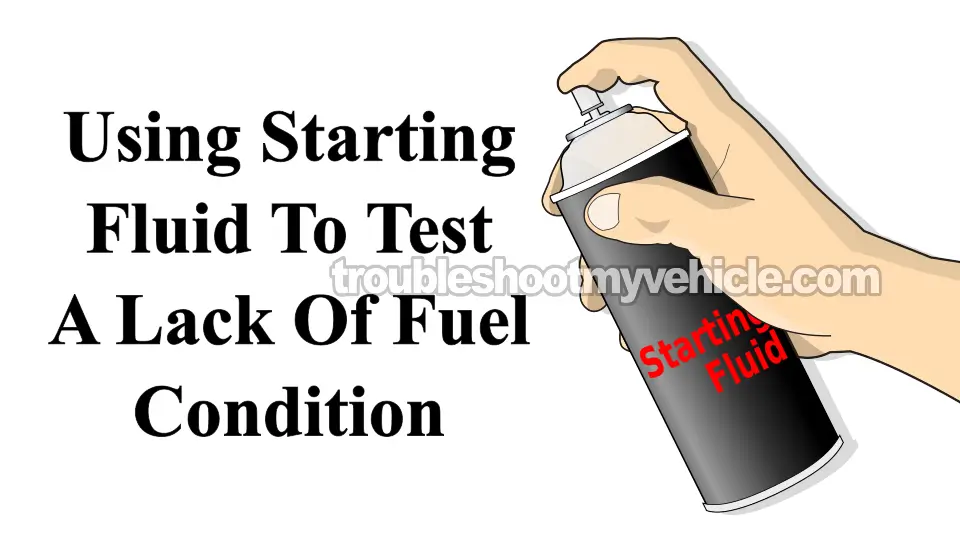
Fuel pumps don't last forever and the one in your Dodge Ram van will eventually fail, resulting in either an engine no-start issue or decreased engine performance.
Fortunately, diagnosing the fuel pump (as good or bad) is a pretty simple affair accomplished using a fuel pressure test gauge.
In this tutorial, I'll explain how to do a fuel pressure test and also how you can use starting fluid to pinpoint whether an engine no-start is caused by a lack of fuel.
Contents of this tutorial:
APPLIES TO: This tutorial applies to the following Dodge Ram vans:
- 3.9L V6 Dodge Ram B150 Van: 1992, 1993.
- 3.9L V6 Dodge Ram B250 Van: 1992, 1993.
- 3.9L V6 Dodge Ram B1500 Van: 1994, 1995, 1996, 1997, 1998, 1999, 2000, 2001, 2002, 2003.
- 3.9L V6 Dodge Ram B2500 Van: 1994, 1995, 1996, 1997, 1998, 1999, 2000, 2001, 2002, 2003.
Fuel Pump Circuit Wiring Diagram:
- Fuel Pump Circuit Wiring Diagram (1992-1993 3.9L V6 Dodge Ram Van).
- Fuel Pump Circuit Wiring Diagram (1994 3.9L V6 Dodge Ram Van).
- Fuel Pump Circuit Wiring Diagram (1995 3.9L V6 Dodge Ram Van).
- Fuel Pump Circuit Wiring Diagram (1996 3.9L V6 Dodge Ram Van).
- Fuel Pump Circuit Wiring Diagram (1997 3.9L V6 Dodge Ram Van).
- Fuel Pump Circuit Wiring Diagram (1998-1999 3.9L V6 Dodge Ram Van).
- Fuel Pump Circuit Wiring Diagram (2000-2003 3.9L V6 Dodge Ram Van).
Symptoms Of A Bad Fuel Pump
A fuel pump usually fails in one of two ways:
- Complete failure: It simply ceases to function and no fuel is sent to the fuel injectors. As a result, your van's engine will crank but fail to start.
- Degraded performance: Despite still operating and the engine starting, the pump delivers insufficient fuel to keep it running properly under load. And by "under load" I mean once you put the transmission in Drive and step on the accelerator.
If the fuel pump is starting to fail but can still get the engine to start, you'll usually see one or more of the following symptoms:
- Rough idle: Since the engine is not being supplied with enough fuel, it'll run rough or erratically at idle.
- Hard starting: To get the engine started, you've got the crank the engine a long time.
- Lack of power: This is especially noticeable when you're accelerating the van on the road. The power and responsiveness of the engine just isn't there anymore.
- Backfires: A characteristic "popping" sound can be heard coming from the intake manifold when accelerating. This is another classic sign the engine isn't getting enough fuel.
- Running lean: A faulty fuel pump will result in a lean air/fuel mixture, triggering diagnostic trouble codes for oxygen sensors or for "lean" air/fuel mixture issues.
Regardless of whether your van's fuel pump is completely dead or on its way out, doing a fuel pressure test is definitely gonna help you determine if the fuel pump is to blame.
What is a "lean" air/fuel mixture? For the engine to run efficiently, it requires a precise mix of air and gasoline —which is referred to as the air/fuel mixture. The engine management system (aka the fuel injection computer) adjusts the fuel amount based on how much air is entering the engine, so the mixture stays just right for any engine operating condition.
If, for any reason, the fuel injection computer doesn't supply enough fuel for the amount of air coming in, the mixture is described as "lean".
If the computer instead delivers fuel in excess of the incoming air, the air/fuel mixture becomes "rich".
Fuel Pressure Specifications
| 1992 |
|---|
| 39 PSI (Key On Engine Off -KOEO) |
| 1993 |
|---|
| 31 PSI (Key On Engine Off or Key On Engine Running with vacuum hose connected to fuel pressure regulator) |
| 8-10 PSI higher with Engine Running and vacuum hose disconnected to fuel pressure regulator) |
| 1994-1995 |
|---|
| 35-45 PSI (Key On Engine Running At Idle -No Load) |
| 1996-2003 |
|---|
| 44-54 PSI (Key On Engine Off -with scan tool activating the fuel pump) |
Where To Buy A Fuel Pressure Test Gauge
A fuel pressure test gauge is one of those must-have tools every serious DIYer should have in their toolbox.
The cool thing is, they don't cost an arm and a leg, and you can find them at just about any auto parts store.
If you'd like to save some bucks, check out the following fuel pressure test kits (compatible with your 3.9L V6 Dodge Ram Van):
Disclosure: As an Amazon Associate, I earn from qualifying purchases. If my tutorials help you, using these links is an easy way to support the site at no extra cost to you. Thank you!
To measure the fuel pressure in your Dodge Ram van, you'll connect a fuel pressure test gauge to the Schrader valve on the fuel injector rail.
On the fuel injector rail, the Schrader valve is located at the back of the engine, on the driver's side —right near the distributor and beside injector #5 (see image 2 of 2 above).
The Schrader valve looks a lot like the air valve on a bicycle tire —same design, just a bit bigger. Although it works like a tire valve, this one's built specifically to allow accurate fuel pump pressure readings.
NOTE: This tutorial covers 3.9L V6 Dodge Ram vans produced between 1992 and 2001, so your Schrader valve may not look exactly like the one in image 2 of 2. It will still be located in the same corner of the engine and look similar.
IMPORTANT: For Dodge Ram vans manufactured from 1996 to 2001, a scan tool is required to activate the fuel pump to read its fuel pressure. If you don't have access to such a tool, no worries. The instructions below take into account having one and not having one.
Okay, here's what we're gonna do:
- 1
Place a shop towel under the Schrader valve area.
The shop towel will absorb any fuel that may leak during the next step. - 2
Connect your fuel pressure gauge to the Schrader valve, as shown in image 1 of 2.
- 3
Have a helper quickly switch the key on and off several times to check for leaks around the Schrader valve.
If any signs of fuel leaking appear at the connection, tighten the adapter a bit more (by hand only).
Key On Engine Running (KOER) Only:
- 4
Start the engine.
- 5
Your gauge should show the specified pressure for your van's year model.
Click here: Fuel Pressure Specifications.
Key On Engine Off (KOEO) No Scan Tool Only:
- 4
Unplug the ignition coil from its 2-wire connector.
NOTE This test is only applicable to models with a KOEO fuel pressure specification. - 5
Crank the engine, then release the key.
- 6
The gauge should display the correct fuel pressure for your van's specific model year.
Click here to view the specs: Fuel Pressure Specifications.
Key On Engine Off (KOEO) With Scan Tool Only:
- 4
Connect your scan tool to your van's diagnostic link connector (DLC).
- 5
With the scan tool, enable the fuel pump.
- 6
Your gauge should display the correct pressure for your van's specific model year.
Click here: Fuel Pressure Specifications.
Interpreting your test results:
CASE 1: 0 PSI reading. This result confirms that no fuel is reaching the engine.
In most instances, this is the result of a bad fuel pump and it needs to be replaced. In some cases, the fuel pump isn't functioning because the fuel pump relay isn't sending it power.
Before replacing the fuel pump, make sure it's receiving between 10-12 Volts DC while cranking the engine to rule out a bad fuel pump relay.
CASE 2: The pressure is lower that specified. This tells you that the fuel pump is on its way out and needs to be replaced.
CASE 3: The pressure is as specified. This is the correct and expected test result. If your van's engine isn't starting, you can rule out the fuel pump itself as the cause.
TEST 2: Using Starting Fluid To Confirm Lack Of Fuel

A quick way to check if your van's no-start issue is due to a lack of fuel (possibly from a weak or bad fuel pump) is by performing the starting fluid test.
This simply involves spray starting fluid directly into the throttle body and then cranking the engine.
You'll get one of two results:
- Engine starts: If the problem is fuel-related, the engine will fire up briefly and run for a few seconds until the starting fluid burns off.
- Engine doesn't start: This suggests that fuel delivery isn't the issue behind the no-start condition.
Keep in mind —this isn't the most precise method for diagnosing a bad fuel pump. Still, it's a solid first step that can help point you in the right direction as you troubleshoot the engine no-start problem.
NOTE: For the test to be reliable, all six spark plug wires need to be firing spark. If you're unsure, do a spark test first before moving ahead with the starting fluid test.
IMPORTANT: Once you've sprayed starting fluid into the throttle body, make sure to place the air cleaner assembly back in position before cranking the engine. This safety step helps prevent flames from shooting out of the throttle body in the event of a backfire.
Here's what to do:
- 1
Pull off the air cleaner assembly from the throttle body. Don't remove it completely —you'll need to put it back on in a second.
- 2
Open the throttle plate and spray some starting fluid into the bore.
- 3
Place the air cleaner assembly back over the throttle body. You don't need to tighten the clamp.
- 4
Crank the engine once the air cleaner assembly is back on and you're standing clear.
- 5
You'll see one of two things:
1.) The engine will start, then after a few seconds shut off.
2.) It will simply crank and not start.
Here's what those results mean:
CASE 1: Engine started and ran briefly. This usually means there's a fuel delivery issue —most likely the fuel pump is bad.
I still recommend grabbing a fuel pressure test gauge and checking the pressure to be sure. You can follow the steps here: TEST 2: Checking Fuel Pressure With A Fuel Pressure Gauge.
CASE 2: Engine didn't start at all. That usually means a lack of fuel's not the issue.
But since this test isn't super exact, it wouldn't hurt to run a pressure check with a gauge to confirm. Go to: TEST 2: Checking Fuel Pressure With A Fuel Pressure Gauge.
More 3.9L V6 Dodge Ram Van Tutorials
I've written quite a few 3.9L V6 Dodge Ram van 'how to test' tutorials. You can find them in this index:
Here's a sample of the tutorials you'll find in the index:
- How To Test The TPS (1997-2003 3.9L V6 Dodge Ram Van).
- How To Test The MAP Sensor (1997-2003 3.9L V6 Dodge Ram Van).
- How To Test For A Blown Head Gasket (1989-2003 3.9L V6 Dodge Ram Van).
- How To Test The Engine Compression (1989-2003 3.9L V6 Dodge Ram Van).

If this info saved the day, buy me a beer!




